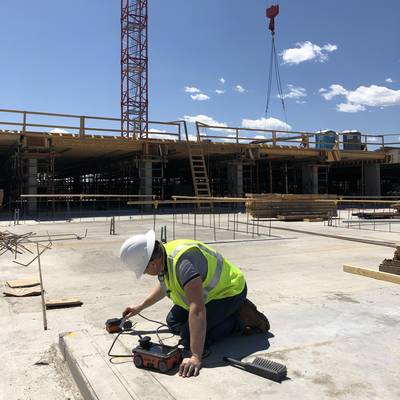Reliable Concrete Scanning Techniques for Construction Projects
Reliable Concrete Scanning Techniques for Construction Projects
Blog Article
Reveal the Transformative Power of Concrete Scanning in Making The Most Of Efficiency and Safety And Security
Concrete scanning has actually arised as an important tool in the building industry, supplying unmatched benefits in boosting project performance and making sure safety and security requirements. The transformative power of concrete scanning lies in its ability to offer thorough insights and real-time data, reinventing just how tasks are intended and executed.
Relevance of Concrete Scanning
Ensuring the architectural stability and security of building and construction tasks begins with the vital step of carrying out complete concrete scanning. Concrete scanning is a non-destructive approach utilized to find and map subsurface elements within concrete frameworks.
The significance of concrete scanning can not be overemphasized, as it plays a crucial function in stopping crashes, reducing project delays, and ensuring the long-term resilience of the building and construction. By determining prospective risks before the building stage starts, building contractors can apply appropriate safety procedures and make educated choices concerning the style and execution of the task. Additionally, concrete scanning helps in maximizing project timelines and spending plan by staying clear of unexpected expenses and delays that may emerge as a result of unanticipated obstructions within the concrete. Eventually, spending in comprehensive concrete scanning is a proactive approach that enhances both effectiveness and safety in building and construction tasks.
How Concrete Scanning Works
Concrete scanning runs as an essential tool in building and construction tasks by using sophisticated modern technologies to identify and map subsurface components without triggering architectural damages. Ground Penetrating Radar (GPR) and Electromagnetic Induction (EMI) are two primary approaches utilized in concrete scanning. GPR works by giving off high-frequency radar pulses right into the surface, which bounce back when they experience subsurface items or spaces. The moment considered the signal to return suggests the deepness and place of the objects. EMI, on the other hand, utilizes electromagnetic fields to determine variations in material structures, such as determining rebar or avenues within concrete structures.
Throughout the scanning process, the information accumulated is evaluated in real-time, permitting immediate identification of prospective risks or obstacles below the surface. This information aids in decision-making, guaranteeing that building and construction activities proceed securely and successfully. Additionally, 3D imaging software can be made use of to produce topographic maps of the subsurface aspects, better enhancing task preparation and implementation. By employing these sophisticated innovations, concrete scanning dramatically minimizes the risk of expensive problems and injuries on building and construction sites.
Advantages of Concrete Scanning
One of the key benefits of concrete scanning is the ability to discover and situate ingrained items such as rebar, post-tension cables, and channels accurately. Concrete scanning helps in preparation and developing more successfully, as it offers accurate info regarding the place and depth of architectural elements.

Case Research Studies: Concrete Scanning Success

In an additional situation, a building business utilized 3D concrete scanning to assess the problem old concrete structures in a historical building. The thorough scans provided beneficial insights into the degree of deterioration and aided prioritize upkeep efforts successfully. By proactively attending to locations of concern identified via scanning, the firm was able to prolong the lifespan of the structure and ensure passenger security.
These study emphasize the transformative helpful hints power of concrete scanning in enhancing efficiency, accuracy, and safety and security in building and construction tasks.
Applying Concrete Scanning in Projects
Carrying out sophisticated scanning technologies during building and construction jobs has actually become progressively crucial for boosting precision and security. By incorporating concrete scanning into job planning and execution, building teams can identify prospective risks, such as rebar or post-tension cables, concealed within concrete frameworks. This positive approach minimizes the risk of mishaps, delays, and expensive rework, ultimately leading to extra reliable project timelines and budget plans.
To execute concrete scanning effectively, project managers ought to work together very closely with knowledgeable scanning professionals to establish the most ideal scanning methods for the particular task needs. Engaging scanning professionals from the very early stages of a task enables the team to produce thorough scanning strategies that address crucial locations of concern and make sure complete data collection.
Moreover, including concrete scanning into normal project process can streamline decision-making processes, as real-time check data supplies immediate understandings into the condition of concrete structures - Concrete Scanning. This data-driven technique helps with educated analytical and enables groups to make modifications promptly, promoting a culture of effectiveness and safety and security throughout the project lifecycle

Final Thought
Finally, concrete scanning plays an essential role in enhancing performance and safety in building jobs. By using sophisticated technology to map and detect out underlying frameworks within concrete, this procedure aids to avoid pricey mistakes, make sure structural integrity, and decrease threats on site. With the capability to reveal covert aspects and provide exact information, concrete scanning shows to be a useful device for optimizing job outcomes and maximizing total success.
Concrete find more scanning is a non-destructive approach utilized to identify and map subsurface aspects within concrete structures. Furthermore, concrete scanning assists in optimizing project timelines and budget plan by preventing unanticipated prices and delays that might occur due to unexpected obstructions within the concrete. One noteworthy situation research includes a large renovation task where concrete scanning played an important function in guaranteeing project success.In one more instance, a construction company made use of 3D concrete scanning to evaluate the condition of maturing concrete structures in a historic structure. By integrating concrete scanning right into task preparation and implementation, construction teams can determine potential dangers, such as rebar or post-tension cables, concealed within concrete structures.
Report this page